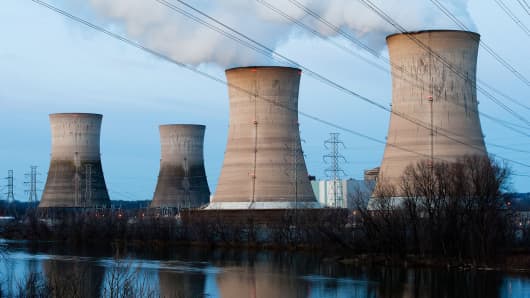We have seldom seen such an obvious public-policy choice as ensuring that America's existing nuclear energy plants continue to operate. Unfortunately, many nuclear plants are threatened by a variety of conditions that contribute to their risk of premature closure. This is due, in large part, to a perfect storm of economic and policy challenges, including sluggish demand for electricity, the onset of cheap natural gas, and a constrained transmission system.
As we've experienced in our time as elected officials, there comes a time when action must be taken to do what's best for constituents. In this case, it's electricity consumers and Americans across the country. If nothing is done, the future likely entails a less dependable electricity supply, higher costs to consumers, and greater carbon emissions. This is not a course most Americans would embrace, and prematurely closing plants before the end of their useful lifespan would be akin to shooting ourselves in the foot.
Read MoreWho wins when crude is far cheaper than gas?
The United States' nuclear energy plants together contribute an impressive $60 billion to annual gross domestic product (GDP) annually, according to a report from the economic-consulting firm Brattle Group that was commissioned by Nuclear Matters. Nuclear plants provide $10 billion in federal-tax revenues and $2.2 billion in state tax revenues annually, and account for about 475,000 full-time jobs (both direct and secondary), the report found.
With regard to their ability to limit greenhouse gas emissions, the report found that the U.S. nuclear fleet prevents about 573 million tons of carbon emissions each year, which is equivalent to an additional $25 billion contribution annually if valued at the federal government's social cost of carbon estimate. This makes clear that it would be virtually impossible to meet our nation's clean energy goals, including President Obama's Clean Power Plan, without nuclear. These plants also enable us to avoid 650,000 tons of nitrogen oxide (NOx) and over one million tons of sulfur dioxide (SO2) emissions annually, which are together valued at $8.4 billion using the National Academy of Science's externality estimates.
Finally, the report found that nuclear power helps to keep electricity prices low for consumers and businesses across the country; without nuclear energy, retail electricity rates stand to increase by about 6 percent, on average. This has a real impact on consumers' wallets at a time when many Americans are already struggling to make ends meet.
Read MoreSaudi Arabia hangs on with cheap oil — but for how long?
The findings of this report plainly show what we stand to lose as a nation if these plants continue to be at risk of shutting down prematurely.
So what can be done? Existing nuclear plants must be properly recognized in electricity markets for the value that they provide. Different solutions may certainly be called for in different states, in the regional transmission organizations, and at FERC. But in general, it will be important to consider new legislative, regulatory and/or competitive market policies to recognize the zero carbon emissions value of nuclear energy plants and a variety of energy sources.
In Illinois, for example, a recent proposal for a low carbon portfolio standard (LCPS) represents the right sort of solution that is the first of its kind to value nuclear energy plants for their carbon-free attributes. The LCPS proposal would require the state's electric utilities to purchase a specified percentage of low carbon energy credits from sources that emit zero or low amounts of carbon dioxide, appropriately valuing nuclear power as a carbon-free resource, and ultimately, helping to preserve its nuclear plants and the benefits they provide. We're hopeful that this legislation can serve as a model for the types of policies and solutions that other states can look to when assessing how best to value nuclear energy plants.
Read MoreJapan's return to nuclear is met with fear and loathing
The reliability of nuclear plants and other baseload generation to the electric grid should also be recognized. Last winter, when record low temperatures threatened part of the nation with brownouts, our nuclear plants continued to provide dependable power. This also should be valued by policy makers. Additionally, we recommend the rapid development of electric-transmission capacity in order to better link electricity markets and eliminate current bottlenecks.
Now is the time to maintain the jobs, dependability and carbon-free benefits of nuclear energy plants, and ensure these critical national assets continue to operate for the sake of our long-term energy security. America cannot afford to sleepwalk into the future and remain oblivious about our imminent risks.
Commentary by former Senators Evan Bayh (D-IN) and Judd Gregg (R-NH). They are currently co-chairmen of Nuclear Matters, a campaign designed to engage and inform policy makers and the public about the need to preserve existing nuclear energy plants. Follow them on Twitter @Nuclear_Matters.


